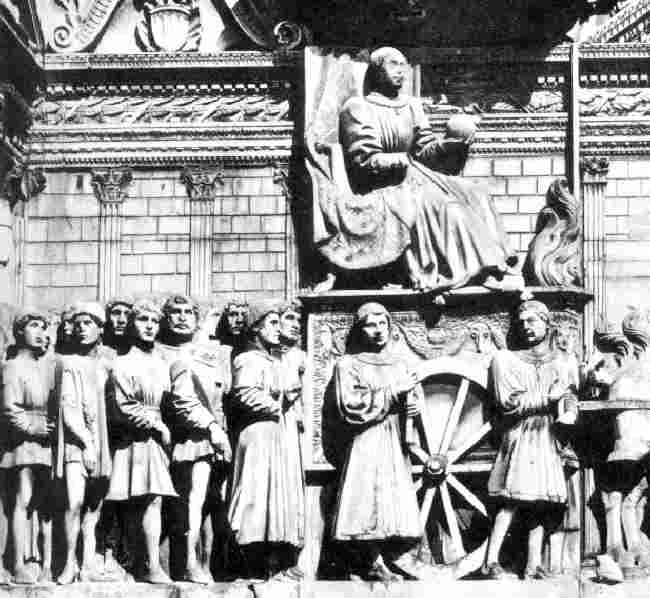

European Royalty: Italian States: Naples--Aragon Rule

Figure 1.--Here we see Alfonso V's triumphal entry into the city of Naples which he has just taken (1444). Note the variety of clothing worn by those following Alfonso's pallet. The relief sculpture is attributed to Isara de Pisa and Francesco Laurana. It was done about 1470.
|
Joanna II of the Anjou dynasty adopted Alfonso V of Aragón as her heir which looked like it might finally reslove the issue. But then she adopted Louis III and René of Anjou setting up a major confrontation. Alfonso defeated René and the pope then invested him with Naples (1442).
Alfonso of Aragon took Naples (1443). Alfonso used the same tactics as Belisario nearly a melinia earlier. Alfonso success follow a protracted attack against the fortified city. He succeeded in breaching the city’s with the help of two master stone masons, "Aniello and Roberto" who showed Alfonso's soldiers a tunnel which ran under the city. under Aragon rule many churches and monuments were built and the city became a cultural mecca. Alfonso through his patronage to Alfons de Borja gave rise to the subsequent Borgia dynasty in Florence. Alfonso's successor, Ferdinand I (Ferrante) defeated a plot by feudal lords who objected to foreign rule and the dimunition of their privliges. The dynastic struggle was not yet over, The Angevin claim to Naples had with the death of René's nephew, Charles of Maine, passed to the French crown (1486). King Charles VIII of France decided to persue that claim and French forces briefly seized Naples (1495). This launched the Italian Wars between France and Spain. King Louis XII, Charles's successor, joined forces with Spain and dethroned Frederick (1501), the last Aragonese king of Naples. He then withdrew from the alliance.
Alfonso I (1443-58)
Alfonso I of Naples is better known to history as Alfonson V of Aragón. Alfonso was born in 1435. His father was Ferdinand I of Aragón. Alfonso became known as Alfonso the magnanimous when upon his accession as king of Aragón (1416) he destroyed a list of nobles that were hostile to him. Alfonso attacked Corsica (1420), but at the request of Queen Joanna II (1371-1435) of the Naples Anjou dynasty, shifted his forces to Naples to help defend the Queen from agaonst Louis III of Anjou. Joanna who had no children, in returned designated Alfonso as her heir. This looked like it might finally resolve the dynastic feuding. But then Joanna changed her mind and adopted Louis III and René of Anjou. This set up a major confrontation. When Joanna died (1435), Alfonso claimed the kingdom. Both the pope and Genoa supported René. The important Genoese fleet defeated Alfonso's Aragon fleet and captured him. He was placed in the hands of the Duke of Milan, Francesco Sforza, who inexplicably took a liking to Alfonso and not only released him, but formed an alliance with him. After several battles Alfonso defeated René and the pope had no choice but to invest him with Naples (1442). Alfonso of Aragon took Naples (1443). Alfonso used the same tactics as Belisario nearly a melenia earlier. Alfonso success follow a protracted attack against the fortified city. He succeeded in breaching the city’s with the help of two master stone masons, "Aniello and Roberto" who showed Alfonso's soldiers a tunnel which ran under the city. We see Alfonso triumphal entry here (figure 1). The sculpture provides details on clothing worn in Naples by youths and men of various ages. Alfonso this founded the basis for Spanish control of southern Italy which lasted several ceturies. Under Aragon rule many churches and monuments were built and the city became a cultural mecca. Alfonso through his patronage to Alfons de Borja gave rise to the subsequent Borgia dynasty in Florence. Alfons was a man of considerable diplomatic skills and played a major role in achieving papal reconition of Alfonso's rule in Naples. [Johnson, pp. 19-21.]
Ferdinand I (1458- )
Alfonso's successor, Ferdinand I (Ferrante) of Sicily, defeated a plot by feudal lords who objected to foreign rule and the dimunition of their privliges. The dynastic struggle was not yet over. The Angevin claim to Naples had with the death of René's nephew, Charles of Maine, passed to the French crown (1486).
Frederick
King Charles VIII of France decided to persue that claim and French forces briefly seized Naples (1495). This launched the Italian Wars between France and Spain. King Louis XII, Charles's successor, joined forces with Spain and dethroned Frederick (1501), the last Aragonese king of Naples. He then withdrew from the alliance.
Sources
Jphnson, Marion. The Borgias (Holr, Reinhart, and Winston: New York, 1981), 232p.
HBRC

Navigate the Boys' Historical Clothing Web Site royal pages:
[Main Naples page]
[Main royal pages]
[Austria]
[Belgium]
[Denmark]
[France]
[Germany]
[Italy]
[Luxemburg]
[Monaco]
[Netherlands]
[Norway]
[Romania]
[Russia]
[Spain]
[United Kingdom]
Created: May 14, 2004
Last updated: May 14, 2004




